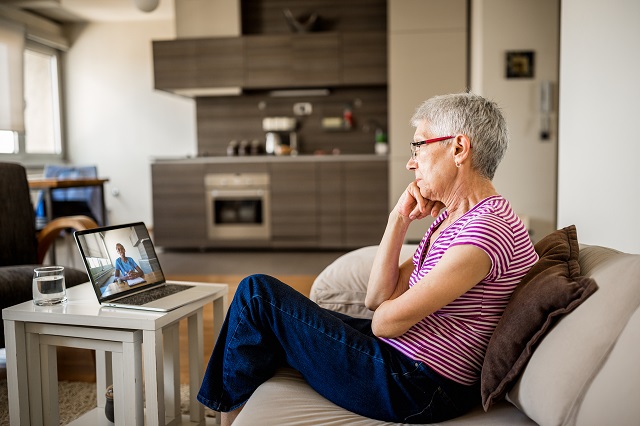
Credit: NoSystem Images / Getty Images
In the past few months, a pandemic of mental health has shadowed COVID-19. Across the country, cases of depression, anxiety, alcoholism, and domestic violence have been on the rise — intensifying an existing shortage of mental health care providers. With shutdowns and social distancing guidelines, access to therapy has also changed dramatically, with a forced transition to online sessions. This switch to telepsychiatry is a big move but, according to Dr. Peter Yellowlees, a psychiatry professor at the University of California Davis, there might be a silver lining.
Yellowlees, the former president of the American Telemedicine Association, began practicing teletherapy nearly 30 years ago to help meet rural psychiatry needs in the Australian outback. Technology advances steadily opened new avenues to online psychiatry, but conventional attitudes and inflexible licensing processes have held the field back for years, Yellowlees says. COVID-19, though, has thrust therapy into a new, virtual world, and Yellowlees believes we are now getting a glimpse of the future.
Three Takeaways:
- During telepsychiatry sessions, Yellowlees often has patients pick up their device to give him a virtual tour of their home, show him family photos or let him peer into their fridge. “You can find out an amazing amount about patients by simply wandering around their home with them,” he says, and this can aid in more accurate diagnosis and treatment.
- Many patients find it easier to speak more openly during virtual sessions, Yellowlees says. Patients are generally more comfortable and trusting when talking to therapists — or anyone, for that matter — online. It’s a side-effect of teletherapy that can bring huge advantages, he says, especially when treating patients who have undergone highly traumatic experiences.
- Privacy issues can present challenges for telepsychiatry, Yellowlees says, especially with stay-at-home advisories forcing families into close quarters. Patients have adapted in a number of ways - finding quiet corners to talk. But by and large, Yellowlees says it’s the car that has become “the new therapy room” — it’s the most convenient, easily-accessible private space around.
Additional Reading:
- An MIT and Harvard team analyzed more than 800,000 Reddit posts to see how conversations about mental health have changed throughout the pandemic. Posts about health anxiety spiked as early as January, but since then mental health posts have risen across the board. This article on the World Economic Forum has more.
- COVID has robbed many of us of our normal routines, and with it, it’s also taken away a sense of place and time. This New York Times article speaks to the brain fog that’s fallen over plenty of us since March.
- Dog adoption rates have soared across the U.S. since shutdowns began. For some, pandemic-puppies have been a fluffy, slobbery remedy to the isolation and anxiety of the pandemic. This piece in The Atlantic has us dreaming of long walks in the dog park.
- MIT Technology Review explores a recent study that shows high rates of mental illness in coronavirus survivors. The exact cause isn’t known, but the study, published in Lancet Psychiatry, looks at more than 60,000 patients to find that 18% face a psychiatric diagnosis less than three months after a COVID-19 diagnosis.

